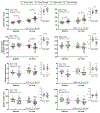Cardiac responses to environmental heat exposure in young and older adults
- PMID: 40720198
- PMCID: PMC12362721
- DOI: 10.1152/japplphysiol.00917.2024
Cardiac responses to environmental heat exposure in young and older adults
Abstract
Older individuals are at a greater risk for adverse cardiovascular events during extreme heat exposure. However, detailed characterization of their cardiac responses to environmental heat exposure is lacking. In 20 young (18-39 yr) and 20 older (>65 yr) adults (50% male in both groups), we document the echocardiography-assessed left ventricular responses to a very hot and dry [DRY, 47°C and 15% relative humidity (RH)] and hot humid (HUMID, 41°C and 40% RH) 3-h heat exposure, with intermittent bouts of light physical activity throughout. In both climates and in both age groups, heat stress 1) increased cardiac output by ∼0.7 ± 0.8 L/min, 2) decreased stroke volume by ∼7 ± 10 mL, and 3) augmented diastolic function through increased atrial contribution to filling by 5 ± 5%. In the DRY climate, mitral annular systolic velocity (s') increased to a greater extent in older subjects (Δ 3.3 ± 2.1 vs. Δ 1.5 ± 1.5 cm/s, P = 0.002), with less difference in HUMID (Δ 2.1 ± 1.3 cm/s vs. 1.4 ± 1.3 cm/s, P = 0.096). Despite these adjustments, systolic blood pressure was only maintained in the younger group and fell consistently in older individuals (0 ± 8 mmHg) in DRY (Δ -11 ± 14 mmHg vs. 1 ± 8 mmHg, P = 0.001) and HUMID (Δ -9 ± 15 mmHg vs. -1 ± 8 mmHg, P = 0.030). In summary, older adults rely on a greater augmentation of systolic function during extreme heat exposure, but the magnitude depends on the heat stress severity.NEW & NOTEWORTHY Comparing healthy young and older adults, we assessed left ventricular cardiac function (using echocardiography) during two separate 3-h extreme heat exposures in a very hot and dry or hot humid climate type. Although the augmentation of diastolic function and cardiac output were similar between age groups, older adults showed a greater increase in mitral annular systolic velocity with heat exposure, indicating a stronger reliance on systolic mechanisms to maintain stroke volume.
Keywords: age; cardiac; cardiovascular; heart; heat.
Conflict of interest statement
Conflicts of interest
No conflicts of interest, financial or otherwise, are declared by the authors.
Figures





References
MeSH terms
Grants and funding
- R01AG069005/HHS | National Institutes of Health (NIH)
- F32HL154565/HHS | National Institutes of Health (NIH)
- F32HL154559/HHS | National Institutes of Health (NIH)
- R01 AG069005/AG/NIA NIH HHS/United States
- F32 HL154565/HL/NHLBI NIH HHS/United States
- 23POST1023065/American Heart Association (AHA)
- F32 HL154559/HL/NHLBI NIH HHS/United States
- T32HL098040/HHS | National Institutes of Health (NIH)
- T32 HL098040/HL/NHLBI NIH HHS/United States
- K01HL160772/HHS | National Institutes of Health (NIH)
- 23CDA1037938/American Heart Association (AHA)
- K01 HL160772/HL/NHLBI NIH HHS/United States
LinkOut - more resources
Full Text Sources
Medical

